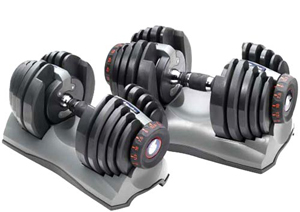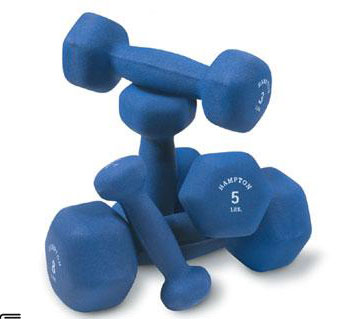 Modern
Modern
 Dumbbells Fixed Weight Dumbbells
Dumbbells Fixed Weight DumbbellsDumbbells
Dumbbells are small bars with weights at the ends. Dumbbell work is very similar to barbell work. With the bars, you can usually only work bilaterally, that is, with both arms at the same time. On the other hand, with the dumbbells we can work univocally or monolaterally, that is, with only one arm. This and the weight disparity are the most characteristic differences between barbell exercises and dumbbell exercises.
Dumbbell exercises are neither better nor worse than those that can be performed with machines, rubber bands or weights. Each muscle according to the objective has a better way to work. For example, if we want to work the maximum hypertrophy of the biceps, we must perform both exercises with dumbbells and with a bar and even with a machine.
Dumbbells help muscle isolation
A classic dumbbell exercise for the biceps is that you can see in the photo, dumbbell bicep crull and thigh support. By doing it with maximum concentration, it allows us better than any other to congest the biceps as a whole. In this case, the elbow flexion is performed only by the brachialis anterior and the biceps brachii, the posture and the use of the dumbbell make it impossible for other muscles or muscle chains to help perform the flexion of the movement.
Dumbbells make exercises more functional
Another difference is that in most exercises with dumbbells these make the work more functional, this is neither an advantage nor a disadvantage, just another peculiarity. For example, pectoral bench work:
- When we do it with a machine, the upward and downward movement of the arms is carried out without displacement neither frontal nor lateral, the rails or chains of the machine fully regulate the movement allowing only the movement of abduction or frontal adduction.
- When we do it with a bar, we add frontal corrections to the acénsense and downward movement, performed by the pectorals, triceps and delts to keep the bar vertical from the chest and not move towards the head or towards the legs.
-
- And when we perform the same exercise but with dumbbells, to the movements of the exercise itself we have to add the frontal and lateral corrections, so in the end many more muscles are involved than the pectoral, triceps and deltoids.
- This means that when free hands dumbbell exercises are performed, the result is more comprehensive and less specific than with a machine or with a bar, and more similar to exercise with elastic bands.
This less specific form of work is ideal for beginners or young athletes, and in other cases for professionals or bodybuilders. It all depends on the objective. But it is clear that for a beginner in bodybuilding, dumbbell work will be more beneficial than machine work, since it will help the integral development of all the muscles of the body.
|
|